Day 1 of a three day Autumn Tour today. It was forecast to be cool and rather windy, though not as bad as the last few days, and with a risk of showers. It was sunny when we set off inland, but we drove into the cloud on the coast. We headed up to north-west Norfolk for the day.
Our first destination was Thornham Harbour. A Curlew was feeding in the edge of the saltmarsh right next to where we parked. Several Meadow Pipits and a Reed Bunting flew up into the bushes as we got out of the car, and a Skylark flew over and dropped down beyond the car park.
A quick look in the harbour channel opposite produced a Greenshank feeding down on the mud, which flew off calling as we approached. A couple of Redshanks and a single Bar-tailed Godwit were a little further along and stayed to let us get a good look at them.
As we got up onto the seawall, a Wheatear flew across the grazing marsh in front of us, flashing its white rump as it went, and landed on a fence post a little further back. Looking inland, we could see a couple of Common Buzzards circling up over the trees, despite the cold and cloudy weather. A single Stock Dove was feeding in the grass out in the middle.
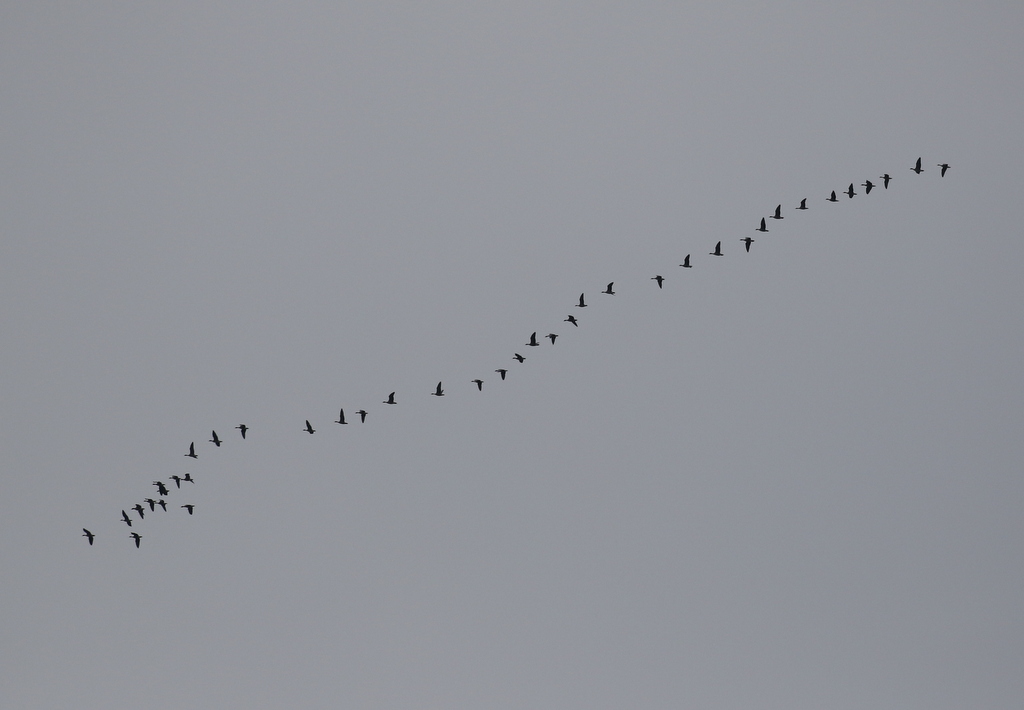 Pink-footed Geese – one of many skeins arriving today
Pink-footed Geese – one of many skeins arriving today
Loud yelping calls overhead alerted us to a small skein of Pink-footed Geese flying past high above us. They were to be a feature of the day today, with groups passing overhead at regular intervals all morning and still to a lesser extent during the afternoon. The Pink-footed Geese are just arriving back for the winter here, after spending the breeding season up in Iceland. Small numbers have been seen over the last few days but this was the first day with a really large number of geese coming in. Impressive stuff, migration in action.
There were hirundines on the move today too. We saw several small groups of Swallows and House Martins making their way west as we walked from the harbour and out along the seawall.
We stopped at the corner to look out across the harbour. There were several waders down in the channel, mostly Redshanks and several more Bar-tailed Godwits. We had a good look at them in the scope. Further over, we picked up a little group of Black-tailed Godwits bathing in the water. An obliging Curlew was feeding on the mud just below the seawall.
 Curlew – feeding on the mud just below the seawall
Curlew – feeding on the mud just below the seawall
A Marsh Harrier was out quartering the saltmarsh. It flew in from the direction of Titchwell, across the harbour and on towards Holme. As it passed over, it flushed lots of birds out of the vegetation below. Lots of waders flew up calling, Redshanks and Curlews, a couple of Little Egrets appeared out of the muddy channels, and a big flock of Linnets circled up above it.
Continuing on along the seawall, we spotted another Wheatear further up perched on a fence post. It kept dropping down onto the grassy bank and then returning to another post, gradually working its way towards us. At one point, it found a caterpillar. It took it back to a fence post, then dropped down into the grass to deal with it. When the Wheatear returned to the fence, it was now very close to us and we had a great look at it through the scope before it flew past and landed again behind us.
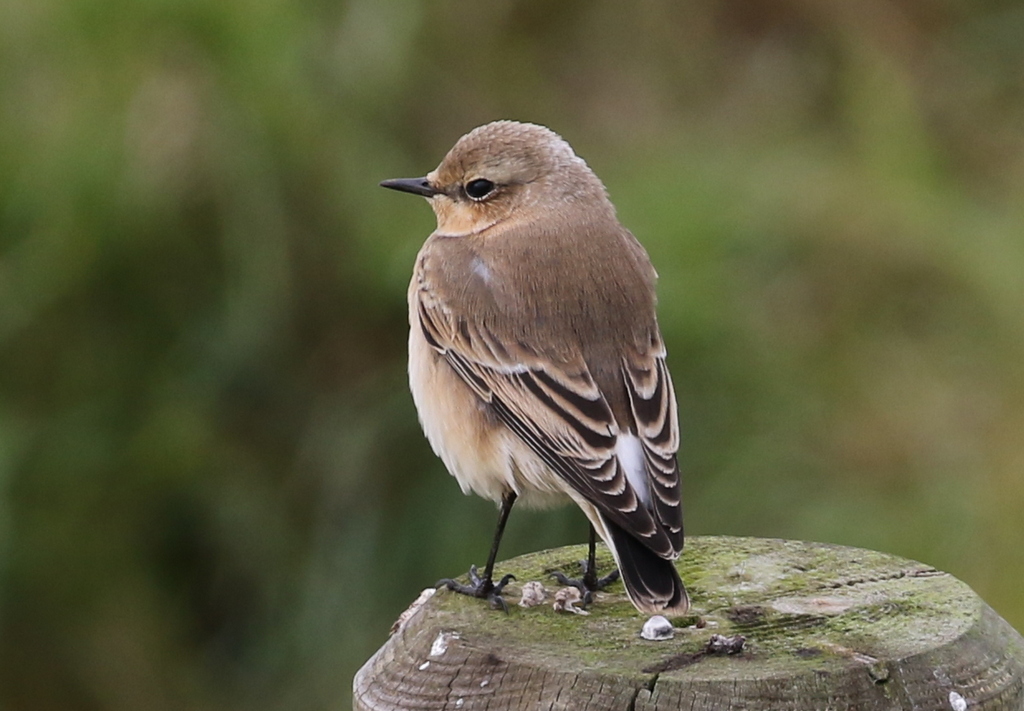 Wheatear – 1 of 2 along the fence along the sea wall at Thornham
Wheatear – 1 of 2 along the fence along the sea wall at Thornham
There were lots of Meadow Pipits down in the grass, but they were very hard to see until they flew. Suddenly they all took off and flew off towards Holme and we could see just how many had been there. Four Skylarks flew in and landed briefly, but were swiftly off again, over the seawall, and disappeared out over the saltmarsh. A little further on, we found another Skylark down in the grass closer to us. It was a young bird – we could see it still had several retained juvenile feathers – but unfortunately it seemed to be suffering with an injured leg, as it was hopping unsteadily through the grass.
With the rain still holding off, we decided to continue on towards the beach. There were lots of Coot out on Broadwater, and three Gadwall in with them. A family of Mute Swans appeared from behind the reeds. Much further over, towards The Firs, we could also see several Little Grebes. A small group of Wigeon flew in and circled over the water before continuing on west, possibly new arrivals.
The calls of several Long-tailed Tits alerted us to an approaching tit flock. They flew towards us from the direction of the dunes and landed in a lone elder bush just in front of the reeds. For a couple of seconds, the small bush was packed with birds – as well as the Long-tailed Tits, we could see several Blue Tits, a Coal Tit and a single Chiffchaff with them. But they didn’t linger here and quickly turned and flew back towards the dunes.
From up in the dunes, we had a quick look out to sea. A single adult Gannet flew past. One of the group picked up a lone duck out on the sea and through the scope we could see it was a moulting Eider, a 1st summer male. Further over, towards the mouth of the Wash, a long line of black dots was a large raft of Common Scoter, but they were too far away to make out much detail even with the scope.
As we made our way back to the car, we were caught by a shower. Thankfully it was not too heavy and the wind was at our backs now. It passed over quickly, before we got back to the car. As we crossed the sluice, the Greenshank flew in and landed briefly, before being spooked by our approach and disappearing off again.
It started to spit with rain again when we got to Titchwell, so we decided to have an early lunch and hope it passed over. It was the right thing to do, because it rained for most of the time we were eating, sheltering under the umbrellas on the tables outside the visitor centre. When it stopped, we got ready to head out onto the reserve. A quick look at the feeders added Chaffinch, Greenfinch, Goldfinch and Great Tit to the day’s list. We didn’t get far along the path before the heavens opened, so we beat a retreat back to the visitor centre. This rain was mercifully brief and it had already started to ease off when we got back. Once it had stopped, we set off to have another go.
Thornham grazing marsh and the reedbed were rather quiet today. There were quite a few Lapwing on the saltmarsh pool. A small flock of Golden Plover circled over. A Little Egret flew in and landed at the back of the saltmarsh pool. We heard a Bearded Tit call from the reeds but it was too windy to see it out there today. We hurried on to Island Hide to get out of the wind.
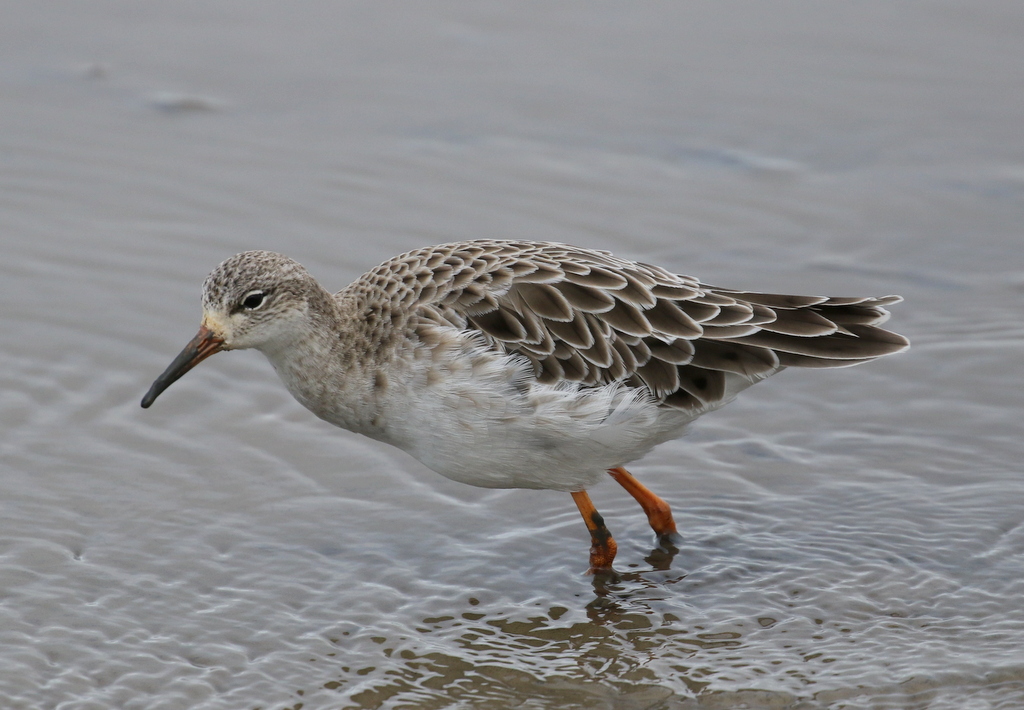 Ruff – still lots feeding on the freshmarsh
Ruff – still lots feeding on the freshmarsh
There were lots of Ruff feeding on the mud right in front of the hide when we arrived. Most were adults, in grey and white non-breeding plumage now. Looking through them, we found a few browner juveniles too. Looking at the males and females side by side, we could see the big size difference between them.
Dunlin numbers have increased recently and there were about 50 on the freshmarsh today. The three Little Stints were very distant at first, but when something spooked all the waders they flew round and landed again much closer. Through the scope, we could see them feeding with Dunlin, giving us a much better impression of just how ‘little’ they really are. There were a few Ringed Plover on the grassy islands too.
The number of Avocet here has really dropped now as most have left for the winter. There were still seven on the freshmarsh, although they were quite a long way back at first. Thankfully when all the waders flushed, they came much closer too. The Black-tailed Godwits on the freshmarsh were all distant too, but there were some Bar-tailed Godwits roosting a little nearer. One of them in particular was still sporting rather rusty-coloured underparts, still moulting out of breeding plumage.
A shout from someone round the other side of the hide kindly alerted us to a Bearded Tit, which was feeding low down along the edge of the reeds. There had been no sign of any Bearded Tits when we arrived and, given the wind, we thought we might struggle to see one today. We had a good look at it through the scope as it hopped around on the mud, in and out of the base of the reeds.
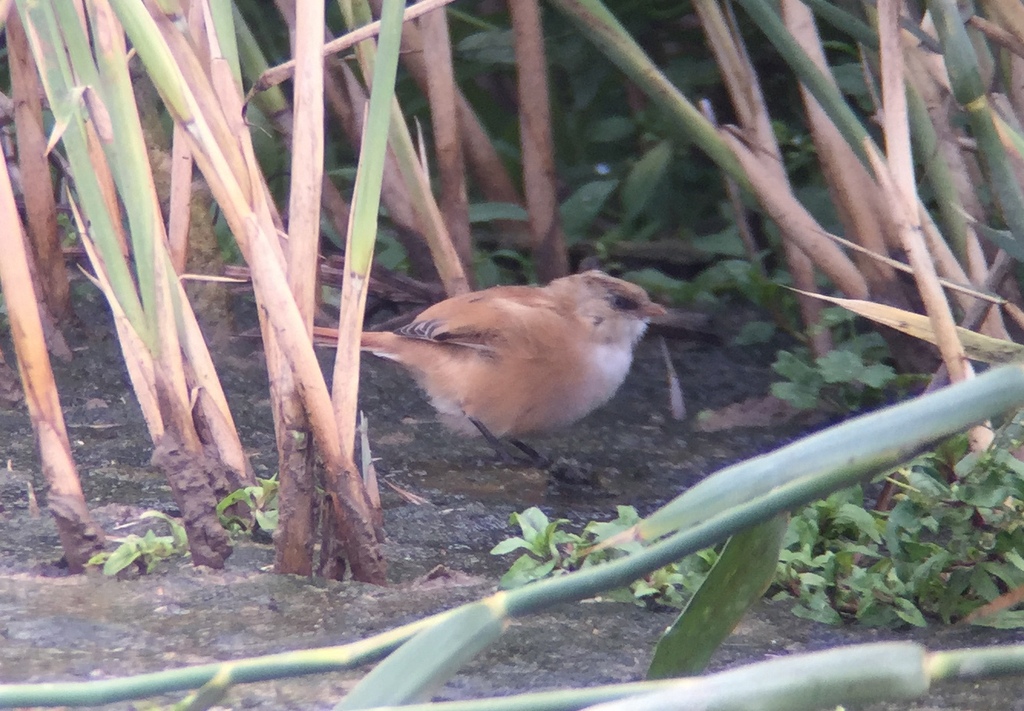 Bearded Tit – feeding on the mud opposite Island Hide
Bearded Tit – feeding on the mud opposite Island Hide
We could see that the Little Stints were now closer to the main path, so while it was dry outside, we decided to make our way round to Parrinder Hide. On the way, we stopped to admire the Little Stints and found that they were right next to the path. We had a great view of them just below us, feeding on the edge of one of the muddy islands. They really are tiny – amazing to think that they are on their way from the arctic down to Africa for the winter, stopping here to refuel.
All three Little Stints were juveniles. We could see the prominent pale ‘braces’ on their mantles. There was noticeable variation between them, seeing the side by side and so close to us. One was more richly coloured, rusty and orange, and one was rather greyer than the other two.
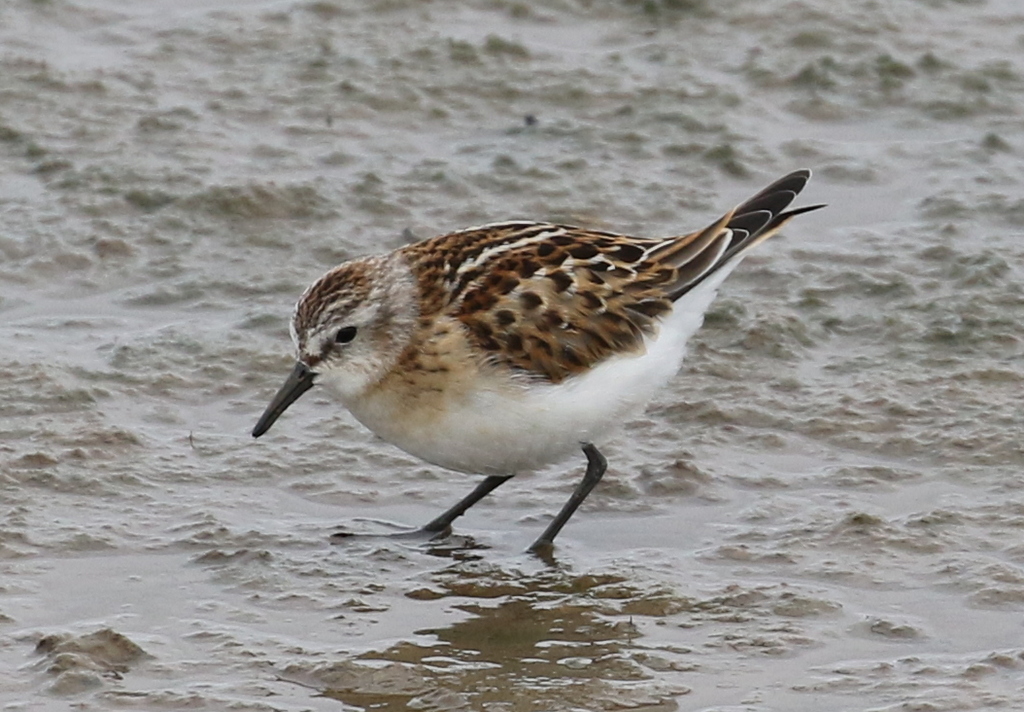 Little Stint – 1 of the 3 juveniles, showing well, right by the main path
Little Stint – 1 of the 3 juveniles, showing well, right by the main path
Tearing ourselves away from the Little Stints, we headed round to Parrinder Hide. One of the first birds we saw from here was a juvenile Spotted Redshank just in front of the hide, presumably the same bird we saw here a couple of days ago. It was with a Common Redshank, giving us a great opportunity to look at the differences between the two. The Spotted Redshank had a noticeably longer and finer bill, a much bolder white supercilium and more extensive pale spots on the wings.
The juvenile Spotted Redshank was feeding in a shallow pool in the wet mud, mostly picking at the surface as it walked around, though it did briefly do some rapid sweeping side to side with its bill in the water. While we were watching it, we also picked up an adult Spotted Redshank further over. In winter plumage, the adult was noticeably paler, with silvery grey upperparts and whiter underparts, paler than the Common Redshank too.
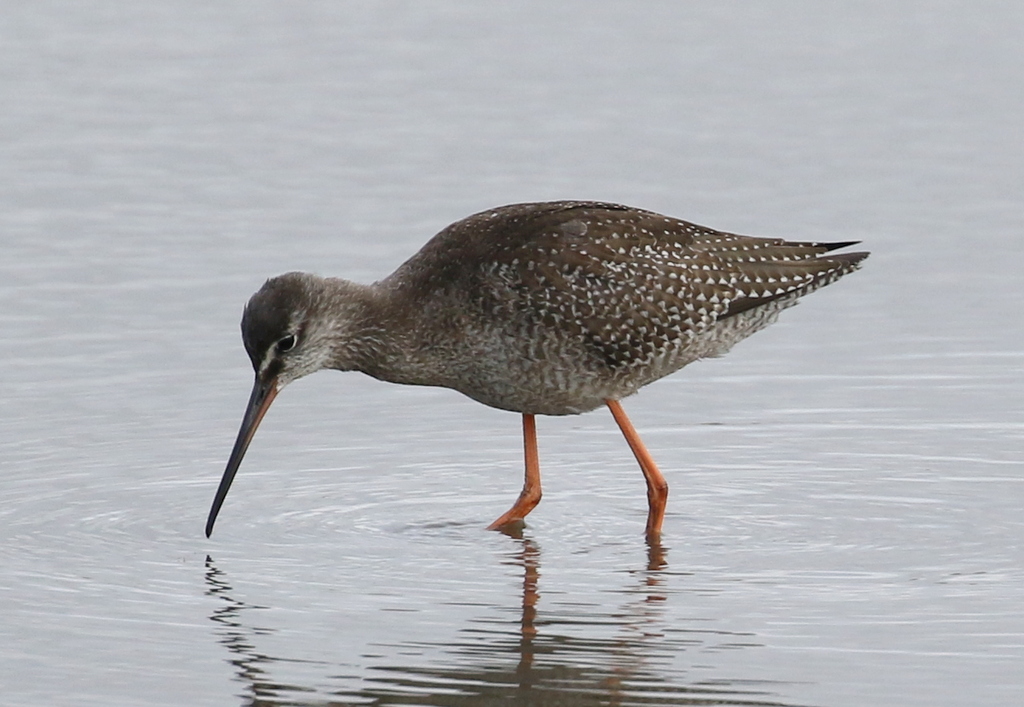 Spotted Redshank – the juvenile, just in front of Parrinder Hide again
Spotted Redshank – the juvenile, just in front of Parrinder Hide again
There were more Ruff here and we had a better view of the Black-tailed Godwits, noting their plain grey backs compared to the more obviously streaked backs of the Bar-tailed Godwits we had seen earlier. A single Common Snipe was feeding in the grass on the edge of the island just inside the fence.
The gulls on the freshmarsh are mostly Black-headed Gulls at the moment. From round at Island Hide earlier, we had found a Mediterranean Gull with them at one point. A winter adult, we were admiring its pure white wing tips when it took off and flew away over the reeds. From Parrinder Hide, we spotted an adult Yellow-legged Gull on one of the islands. Through the scope, we could see its custard yellow legs and grey mantle a shade darker than the Black-headed Gulls it was with. There was also a single Lesser Black-backed Gull and later a few Herring Gulls flew in to bathe, and three young Common Gulls dropped in too.
Most of the male ducks are in duller eclipse plumage at the moment, but some of the resident birds are starting to emerge already. There were a couple of pairs of Gadwall in front of Parrinder Hide, the drakes already in their rather smartly patterned grey and black plumage. A real connoisseur’s duck! There were also lots of Teal on the freshmarsh, a few Wigeon and Shoveler and some Shelduck, but no sign of the Garganey which had been here earlier.
 Black-tailed Godwit – showing well on the Volunteer Marsh
Black-tailed Godwit – showing well on the Volunteer Marsh
With the weather having brightened up a little, we made our way out to the beach. There were some nice close Black-tailed Godwits right by the path at the far end of Volunteer Marsh, which gave us some great views. The water was high in the channel as the tide was just going out, but right at the back, we could see a single Grey Plover on the edge of the mud. It had already largely moulted to winter plumage, with just a few scattered black feathers in its underparts still.
There were several Little Grebes down towards the back of the Tidal Pools today, presumably moved back in for the winter now. There were more waders on here too, more Black-tailed Godwits and Redshanks at first, then further along towards the beach, we could see a line of roosting birds out on one of the spits. Through the scope, we could see there were several Grey Plover, including one stunning bird still mostly in breeding plumage, with black face and belly. Nearby were a couple of Turnstones and further back, in the vegetation, were two Bar-tailed Godwits.
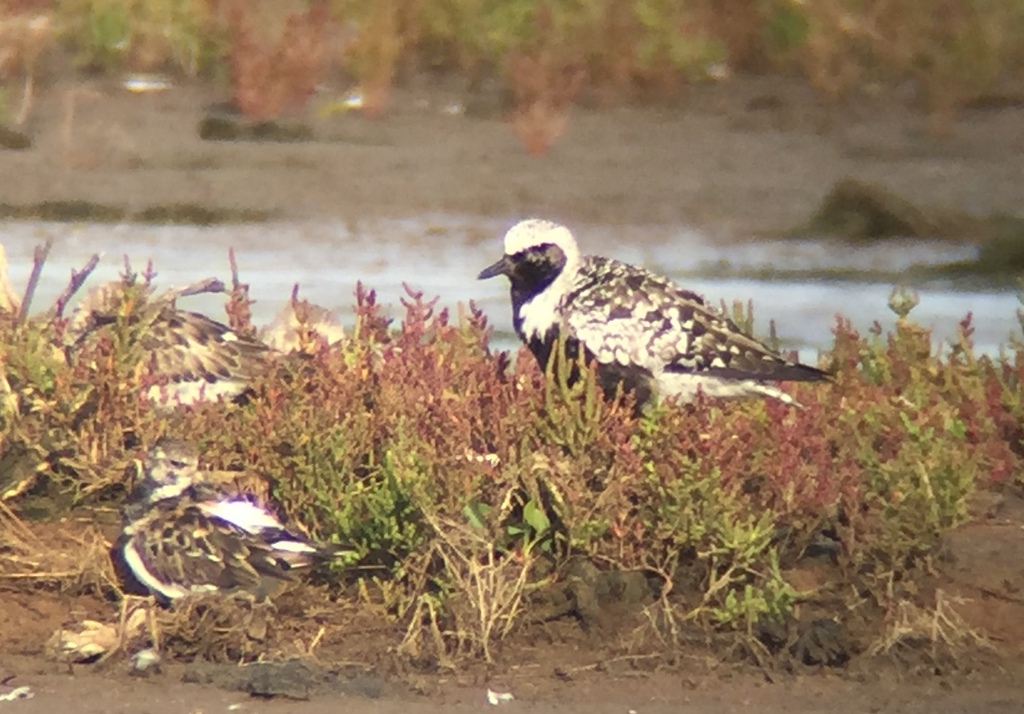 Grey Plover – stunning still mostly in breeding plumage
Grey Plover – stunning still mostly in breeding plumage
Out at the beach, the tide was in. The wind had picked up this afternoon and swung more to the north, which meant the sea was very choppy now and it was hard to see anything out on the waves. Despite the increase in the wind, there didn’t seem to be much moving offshore. There were a few waders out on the beach towards Brancaster, mostly Bar-tailed Godwits and Oystercatchers but running in and out between their legs, like clockwork toys, were several Sanderling too.
It was rather exposed out on the beach so, with time running out, we decided to start to walk back. Two white shapes flew up out of the saltmarsh way off towards Thornham as we walked – a Spoonbill and a Little Egret together. For a moment, it looked like the Spoonbill might fly over in our direction but unfortunately it quickly dropped down again out of view. Two Marsh Harriers were hanging in the air over Thornham grazing marsh and made their way over the trees, presumably heading off to roost.
There were not many insects or other subjects of non-ornithological interest today, perhaps not a surprise given the weather (it was not the sort of day for butterflies or dragonflies!), but on the way back, two things worthy of note did put in an appearance. First, a Devil’s Coach Horse beetle ran across the path. Then, almost back to the trees, we almost trod on a young Smooth Newt on the path.
 Smooth Newt – we nearly trod on this on the path on the way back
Smooth Newt – we nearly trod on this on the path on the way back
Then it was back to the car and time to head for home.
















